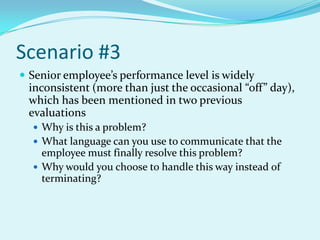This document provides guidance on conducting effective employee performance evaluations. It discusses the purposes of evaluations, including providing feedback, determining rewards and opportunities, and communicating expectations. It outlines prerequisites like having job descriptions and incident files. The evaluation process should be timely, with the manager and employee each preparing a written self-evaluation. Areas to evaluate include responsibilities, accomplishments, skills, and overall performance. Common errors to avoid are also described, and sample language is provided for addressing different performance issues in a constructive manner.
































